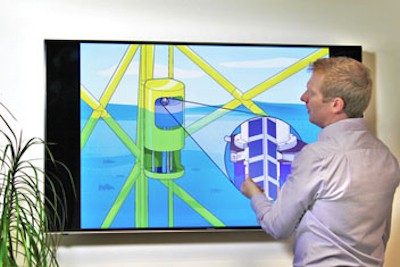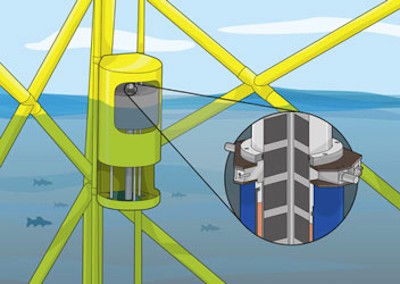The re-designed concept - PowerPod II – is said to represent a major advance for Trident Energy’s WaveDrive project, which is developing a generic power take-off (PTO) system for use in wave energy converters (WECs). The new concept is similar in size to its predecessor but generates 50 per cent more electrical power on each stroke.
Furthermore, the device’s magnetic stack configuration has been optimised to allow the linear generator to operate horizontally, widening the available options for installation and operation. Improvements to the seal design for ‘in-sea’ operation, plus a more robust bearing solution, have been implemented to further increase reliability and reduce maintenance cycles.
According to Alan Mackay, project lead at 42 Technology, the work previously completed by Trident Energy focussed on developing and validating the performance of the generator technology. The original PowerPod was not designed for submersed operation so Trident Energy asked 42 Technology to marinise the basic sub-assemblies of the generator hardware and electrical infrastructure.
Mackay said: “This was achieved by using encapsulation at various stages of the manufacture, with the final assembly being significantly more robust and having at least two barriers to water ingress.
“Similarly, the bearing solution previously employed for the prototype used materials that were not compatible for a salt water environment as it was intended to operate onshore. 42 Technology revised the design to use a lightly loaded primary bearing, using carefully selecting sealed bearings and marine grade materials, for low friction normal operation. Higher lateral loads on the machine are managed by a secondary polymer bearing solution which only comes into service if the armature is outside a designed concentricity tolerance with the magnet stack.”

Mackay further explained that 42 Technology’s previous experience of working with electrical machines, assisted by Trident’s numerical modelling tools, allowed for quick identification of the key performance-related design factors.
The first area the project team focussed on was to review and select the best materials for the design whilst not significantly increasing the capital cost of the generator, said Mackay.
“One of the simple but effective change includes changing the magnet stack design to use a higher grade of ferrite magnet material and optimising the geometric layout of the magnet material used in the generator,” he said. “The second area which resulted in significant improvement in performance was to reduce the air-gap between the armature and magnet stack.
“The air gap acts as a resistor in the magnetic circuit – by reducing this gap, the magnetic reluctance of the circuit is reduced which in turn increase the flux linking the coils, enabling greater performance without increasing the capital cost. However, reducing the air gap whilst maintaining reliability required an improvement in the manufacturing tolerances associated with the magnet stack.
“The magnet stack is created from a number of different parts with sub-assemblies stacked to provide the full length magnet stack. This results in the final tolerance stack, created from the dimensional tolerances of each sub-assembly and how well the sub-assemblies are aligned, limiting the minimum air gap possible.”
Redesign of the individual components and the method of aligning sub-assemblies resulted in reducing the air gap from 5mm to 2mm.

“The work completed by 42 Technology, optimisation of PowerPod II, has led to an improved design of the existing power take-off technology such that it is applicable to a wider range of WECs currently being developed,” said Steve Packard, CEO at Trident Energy. “The higher power output, reduced package size and improved availability - due to reduced maintenance cycles - has encouraged the assessment of the technical detail and detailed review of how PowerPod II could be integrated within different WEC applications and device concepts.”
The detailed design phase for PowerPod II has begun and is scheduled to be complete within six weeks.





Nanogenerator consumes CO2 to generate electricity
Whoopee, they've solved how to keep a light on but not a lot else.